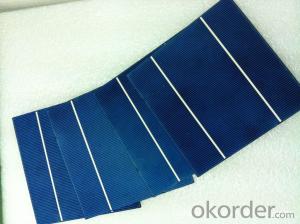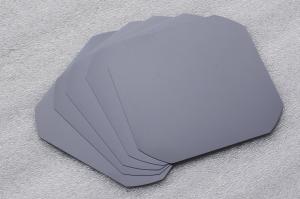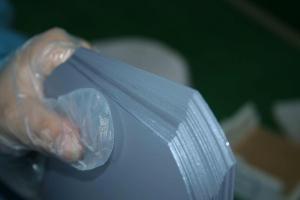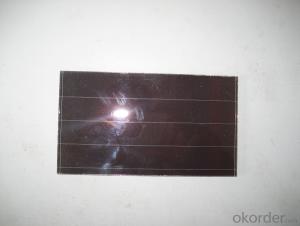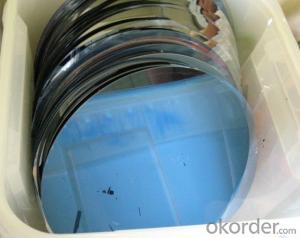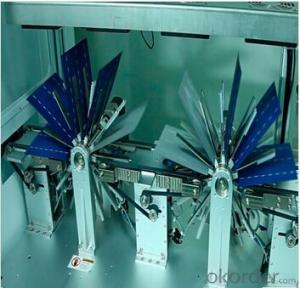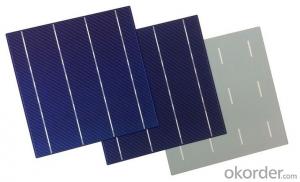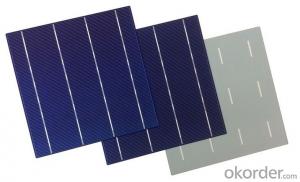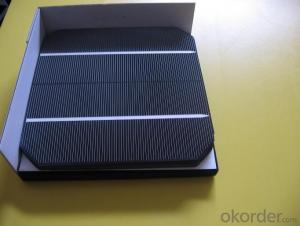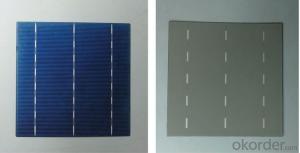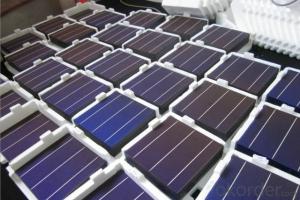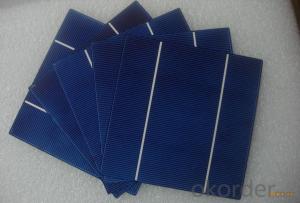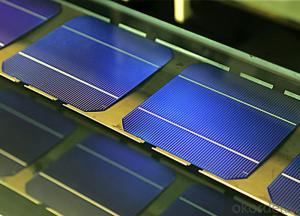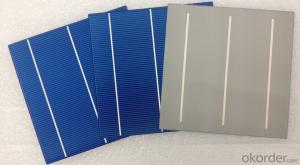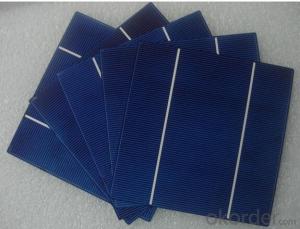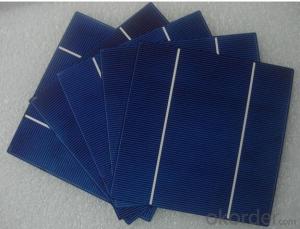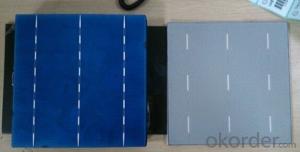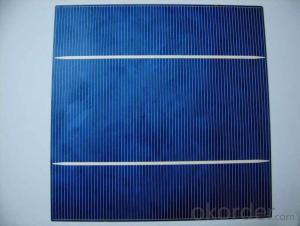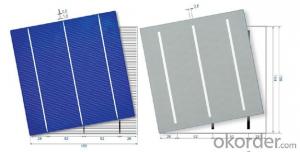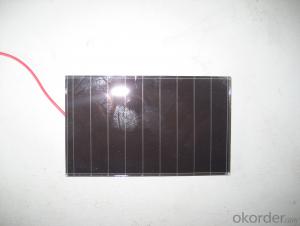Silicon Wafer for Solar Energy - High Quality A Grade Polycrystalline 5V 16.6% Solar Cell
- Loading Port:
- Shanghai
- Payment Terms:
- TT OR LC
- Min Order Qty:
- 1000 pc
- Supply Capability:
- 100000 pc/month
OKorder Service Pledge
OKorder Financial Service
You Might Also Like
Specifications
hot sale solar cell
1.16.8%~18.25% high efficiency
2.100% checked quality
3.ISO9001/ISO14001/TUV/CE/UL
4.stable performance
We can offer you the best quality products and services, don't miss !
POLY6'(156*156)
Polycrystalline Silicon Solar cell
Physical Characteristics
Dimension: 156mm×156mm±0.5mm
Diagonal: 220mm±0.5mm
Thickness(Si): 200±20 μm
Front(-) Back(+)
Blue anti-reflecting coating (silicon nitride); Aluminum back surface field;
1.5mm wide bus bars; 2.0mm wide soldering pads;
Distance between bus bars: 51mm . Distance between bus bars :51mm .
Electrical Characteristics
Efficiency(%) | 18.00 | 17.80 | 17.60 | 17.40 | 17.20 | 16.80 | 16.60 | 16.40 | 16.20 | 16.00 | 15.80 | 15.60 |
Pmpp(W) | 4.33 | 4.29 | 4.24 | 4.19 | 4.14 | 4.09 | 4.04 | 3.99 | 3.94 | 3.90 | 3.86 | 3.82 |
Umpp(V) | 0.530 | 0.527 | 0.524 | 0.521 | 0.518 | 0.516 | 0.514 | 0.511 | 0.509 | 0.506 | 0.503 | 0.501 |
Impp(A) | 8.159 | 8.126 | 8.081 | 8.035 | 7.990 | 7.938 | 7.876 | 7.813 | 7.754 | 7.698 | 7.642 | 7.586 |
Uoc(V) | 0.633 | 0.631 | 0.628 | 0.625 | 0.623 | 0.620 | 0.618 | 0.617 | 0.615 | 0.613 | 0.611 | 0.609 |
Isc(A) | 8.709 | 8.677 | 8.629 | 8.578 | 8.531 | 8.478 | 8.419 | 8.356 | 8.289 | 8.220 | 8.151 | 8.083 |
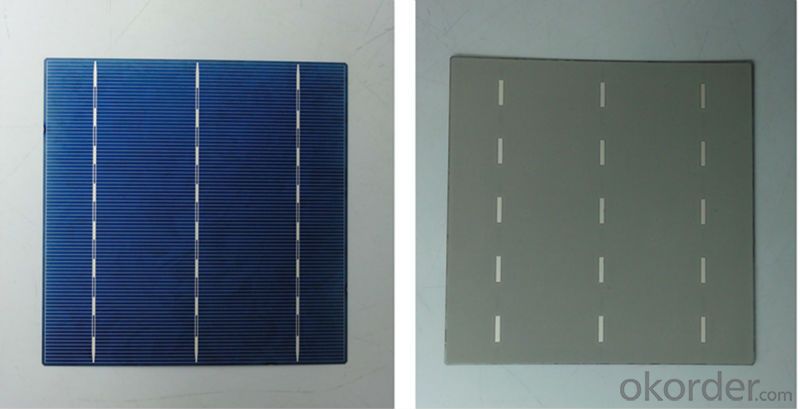
MONO5'(125*125mm)165
Monocrystalline silicon solar cell
Physical Characteristics
Dimension: 125mm×125mm±0.5mm
Diagonal: 165mm±0.5mm
Thickness(Si): 200±20 μm
Front(-) Back(+)
Blue anti-reflecting coating(silicon nitride); Aluminum back surface field;
1.6mmwide bus bars; 2.5mm wide soldering pads;
Distance between bus bars: 61mm . Distance between bus bars :61mm .
Electrical Characteristics
Efficiency(%) | 19.40 | 19.20 | 19.00 | 18.80 | 18.60 | 18.40 | 18.20 | 18.00 | 17.80 | 17.60 | 17.40 | 17.20 |
Pmpp(W) | 2.97 | 2.94 | 2.91 | 2.88 | 2.85 | 2.82 | 2.79 | 2.76 | 2.73 | 2.70 | 2.67 | 2.62 |
Umpp(V) | 0.537 | 0.535 | 0.533 | 0.531 | 0.527 | 0.524 | 0.521 | 0.518 | 0.516 | 0.515 | 0.513 | 0.509 |
Impp(A) | 5.531 | 5.495 | 5.460 | 5.424 | 5.408 | 5.382 | 5.355 | 5.328 | 5.291 | 5.243 | 5.195 | 4.147 |
Uoc(V) | 0.637 | 0.637 | 0.636 | 0.635 | 0.633 | 0.630 | 0.629 | 0.629 | 0.628 | 0.626 | 0.626 | 0.625 |
Isc(A) | 5.888 | 5.876 | 5.862 | 5.848 | 5.839 | 5.826 | 5.809 | 5.791 | 5.779 | 5.756 | 5.293 | 5.144 |
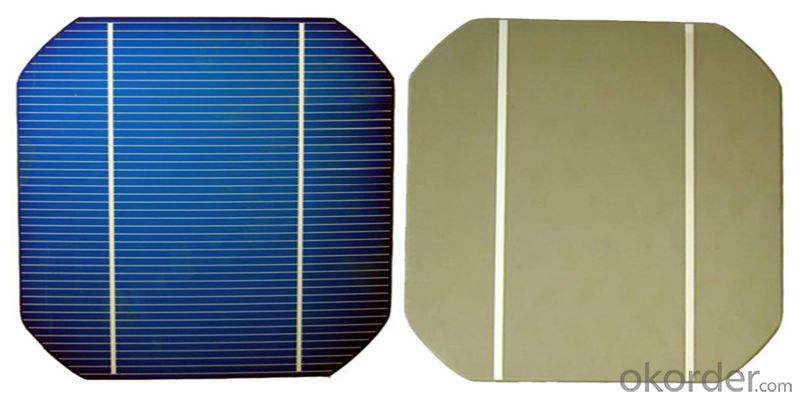
FAQ:
Q:How can i get some sample?
A:Yes , if you want order ,sample is not a problem.
Q:How about your solar panel efficency?
A: Our product efficency around 17.25%~18.25%.
Q:What’s the certificate you have got?
A: we have overall product certificate of ISO9001/ISO14001/CE/TUV/UL
- Q: How do solar silicon wafers contribute to reducing the reliance on imported energy?
- Solar silicon wafers contribute to reducing reliance on imported energy by providing a sustainable and renewable source of electricity generation. By harnessing the power of the sun, solar panels made from silicon wafers convert sunlight into electricity, thus reducing the need for energy imports. This enables countries to rely more on their own domestic solar energy resources, promoting energy independence and reducing the dependence on imported fossil fuels or other non-renewable energy sources.
- Q: What is a silicon wafer
- Si seed a specific crystal orientation (seeds, usually a small ingot) rod inserted into the molten state under Si, and slowly pull up the crystal and a seed crystal and the same column to be produced by controlling the process variables to pull the speed to control the crystal column the diameter can be cut into a crystal column. The small lot, wafer was produced. Crystal column ends can not be cut into available wafer parts can be called the head tail. Preliminary cutting out the wafer, usually can not be used as a rough surface, wafer production, and usually in the subsequent process of polishing, polishing the noun to which. According to the different requirements of wafer fabrication, usually need to rough within wafer doping some impurities, such as P, B etc.
- Q: How do solar silicon wafers contribute to reducing air pollution?
- Solar silicon wafers contribute to reducing air pollution by enabling the production of clean energy through solar panels. These wafers are the key component in the manufacturing of solar cells, which convert sunlight into electricity without emitting any harmful gases or pollutants. By harnessing solar power, we can decrease our reliance on fossil fuels and reduce the amount of greenhouse gas emissions released into the atmosphere, thus mitigating air pollution and its associated environmental and health impacts.
- Q: Are there any alternatives to using solar silicon wafers in solar cells?
- Yes, there are alternatives to using solar silicon wafers in solar cells. Some of these alternatives include thin-film solar cells made from materials such as cadmium telluride (CdTe), copper indium gallium selenide (CIGS), and organic photovoltaics (OPV). These alternative materials offer advantages such as flexibility, lightweight, and potentially lower manufacturing costs. However, their efficiency and stability still need further development to compete with traditional silicon wafers.
- Q: What is the role of doping in solar silicon wafers?
- The role of doping in solar silicon wafers is to introduce impurities into the silicon material in order to alter its electrical properties. This is done to create p-n junctions, which are crucial in the functioning of solar cells. Doping helps in creating the necessary electric fields that enable the conversion of sunlight into electricity by facilitating the separation of charge carriers.
- Q: How is the surface of a solar silicon wafer treated?
- The surface of a solar silicon wafer is typically treated through a combination of cleaning and texturing processes. First, any impurities or contaminants are removed using chemical cleaning methods. Then, the surface is textured to increase its light absorption capacity. This can be achieved by etching the surface with acid or by using laser technology to create tiny pyramids or bumps. These texturing techniques help trap more sunlight and enhance the efficiency of the solar cell.
- Q: What is the typical lifetime energy yield of a solar silicon wafer?
- The typical lifetime energy yield of a solar silicon wafer can vary depending on various factors such as the efficiency of the solar cells, climate conditions, and maintenance. However, on average, a silicon wafer can produce energy for around 25 to 30 years.
- Q: Can solar silicon wafers be used in aerospace applications?
- Yes, solar silicon wafers can be used in aerospace applications. They are commonly used in spacecraft and satellites to provide power through photovoltaic systems, converting solar energy into electricity.
- Q: How is a degradation rate measured in a solar silicon wafer?
- A degradation rate in a solar silicon wafer can be measured by monitoring the decrease in its power output over a specific period of time. This can be done by conducting regular performance tests and comparing the initial power output with the subsequent measurements. The difference in power output indicates the degradation rate, which is typically expressed as a percentage decrease per year.
- Q: Can solar silicon wafers be used in space exploration missions?
- Yes, solar silicon wafers can be used in space exploration missions.
Send your message to us
Silicon Wafer for Solar Energy - High Quality A Grade Polycrystalline 5V 16.6% Solar Cell
- Loading Port:
- Shanghai
- Payment Terms:
- TT OR LC
- Min Order Qty:
- 1000 pc
- Supply Capability:
- 100000 pc/month
OKorder Service Pledge
OKorder Financial Service
Similar products
Hot products
Hot Searches
Related keywords
